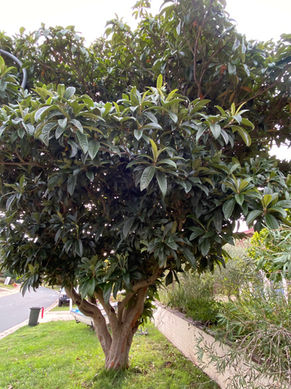
Strategic tree and forest establishment and regeneration on the Southern Tablelands
Eriobotrya japonica
Loquat
MYRTACEAE

Native range: China Height: 3-8 m Width: 4-5 m Flowering: Autumn to early winter Fruiting: Spring to summer Light: Full sun Growth rate: Moderate to fast Soils: Free-draining loam, clay loam and alluvial soils Drought tolerance: Moderate Landscape position: Hillsides, slopes Rainfall range: 600 – 1000 mm Benefits: Loquat (Eriobotrya japonica) is a hardy, evergreen shrub or small-to-medium sized tree with large leaves, a spreading crown, and edible fruits. It can cope with a wide range of soils and conditions, will cope frosts and survive drought. Loquat make good, low maintenance garden plants, producing delicious, mild, sweet tangy fruits in summer. Their large, dark green leaves provide a pleasing foliage contrast, and their canopy casts cool, deep shade. They can also be used as an informal screening plant and will tolerate some pruning to shape. Left unpruned, loquat trees can become quite large with deep, spreading canopies. Cultivated for thousands of years, there are a multitude of cultivars developed from the original Chinese wild populations and from populations subsequently introduced into ancient Japan. A large number of grafted cultivars are available, developed from Chinese or Japanese populations. Plants begin fruiting at 3-5 years, doing best in good, moist soils. Low soil fertility leads to thin fleshy fruit and larger seeds. Plants flower in autumn, and protection from heavy frost is required over winter as the fruits develop. Loquat fruit do not store well but can be used in a variety of preserved foods (stewed fruit, jam, cordial, ice cream, chutney, wine etc.) and could be well suited to sale in local farmers markets. The fruit has a slightly hairy skin which is easily peeled off. Loquat timber is wood is hard, and fine-grained, pinkish in colour and can be used in the same applications as pear wood. Young branches can be used as emergency fodder. The leaves are used in Chinese medicine. Drawbacks: Fruit bruises easily and loses flavour after harvest. Heavy frosts damage flowers and developing fruit, causing poor fruiting. Loquat need to be cross pollinated for good fruit production. Low or no fruiting can occur if pollinator abundance is low or aseasonal wet weather lowers pollination. Fruit can be damaged by birds and animals. Susceptible to fire blight overseas (not yet established in Australia). Uses: Ornamental and landscaping use in parklands and gardens Fruit production Specialty timber fine craft items Propagation: From seed for ornamental use. Graft or select appropriate cultivars from commercial suppliers for fruit growing. Future climate risks: Slow growth, poor flowering and fruiting during extended dry years and heatwaves. Increase of disease and insect attack due to uneven climate. References GBIF: The Global Biodiversity Information Facility (2022) – https://www.gbif.org/species/3024146 Badenes, M.L., Janick, J., Lin, S., Zhang, Z., Liang, G.L. and Wang, W. (2013). Breeding Loquat. In Plant Breeding Reviews, J. Janick (Ed.). https://shorturl.at/ciEO4 Morton, J. 1987. Loquat. p. 103–108. In: Fruits of warm climates – https://shorturl.at/dsAD6 Gardening Austin – https://shorturl.at/ekHS5 Shoaib Shah HM, Waheedb A, Buttc MA (2022) Preharvest Technology and Dynamics of Loquat Fruit Ripening. J Hortic. 9:306 – https://shorturl.at/botv5 Department of Agriculture, Fisheries and Forestry - Fire Blight – https://shorturl.at/iEGQY Image Credits Japanese Plum - Nespera - Eriobotrya japonica CC BY2.0 – https://shorturl.at/dkpyX























